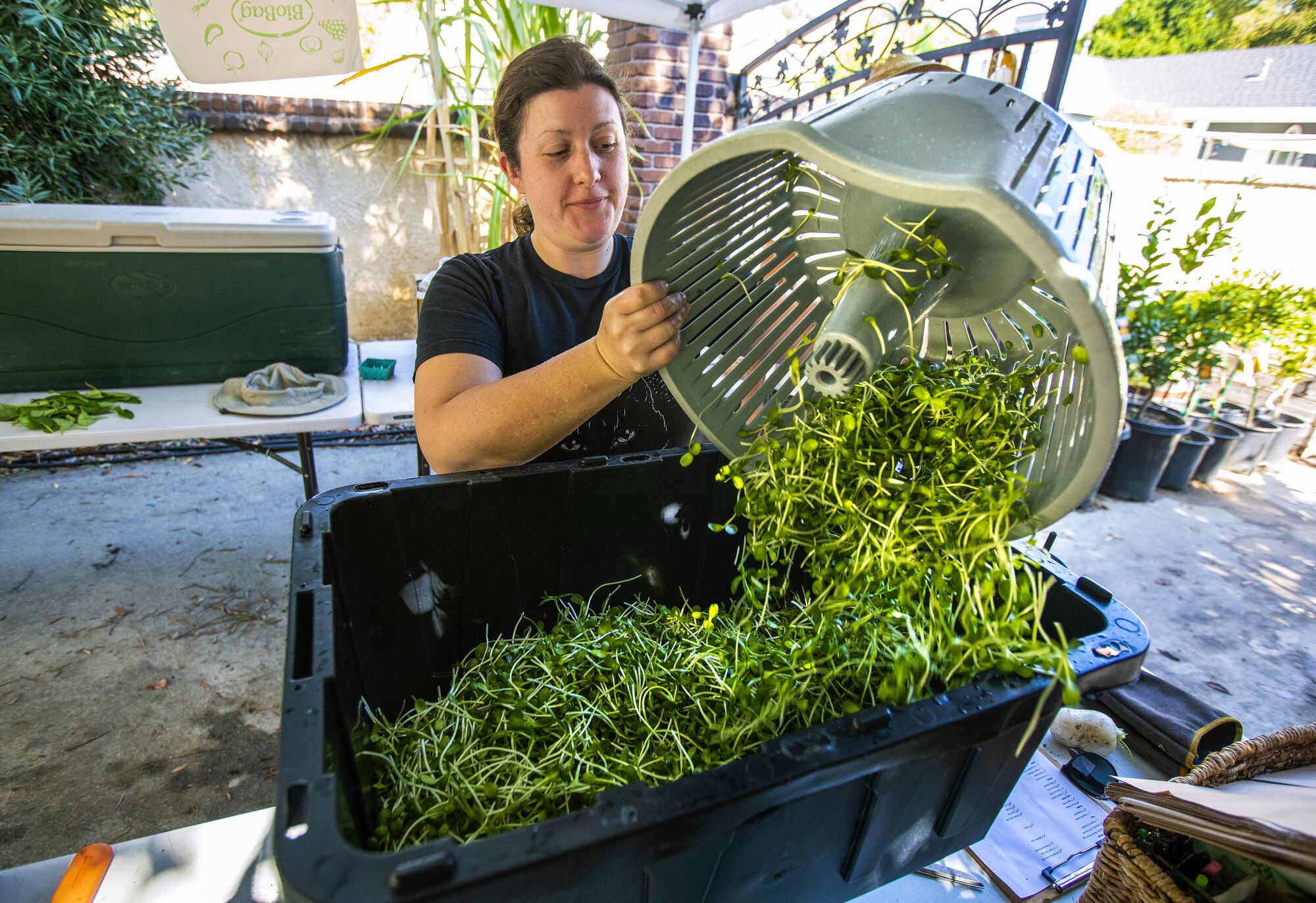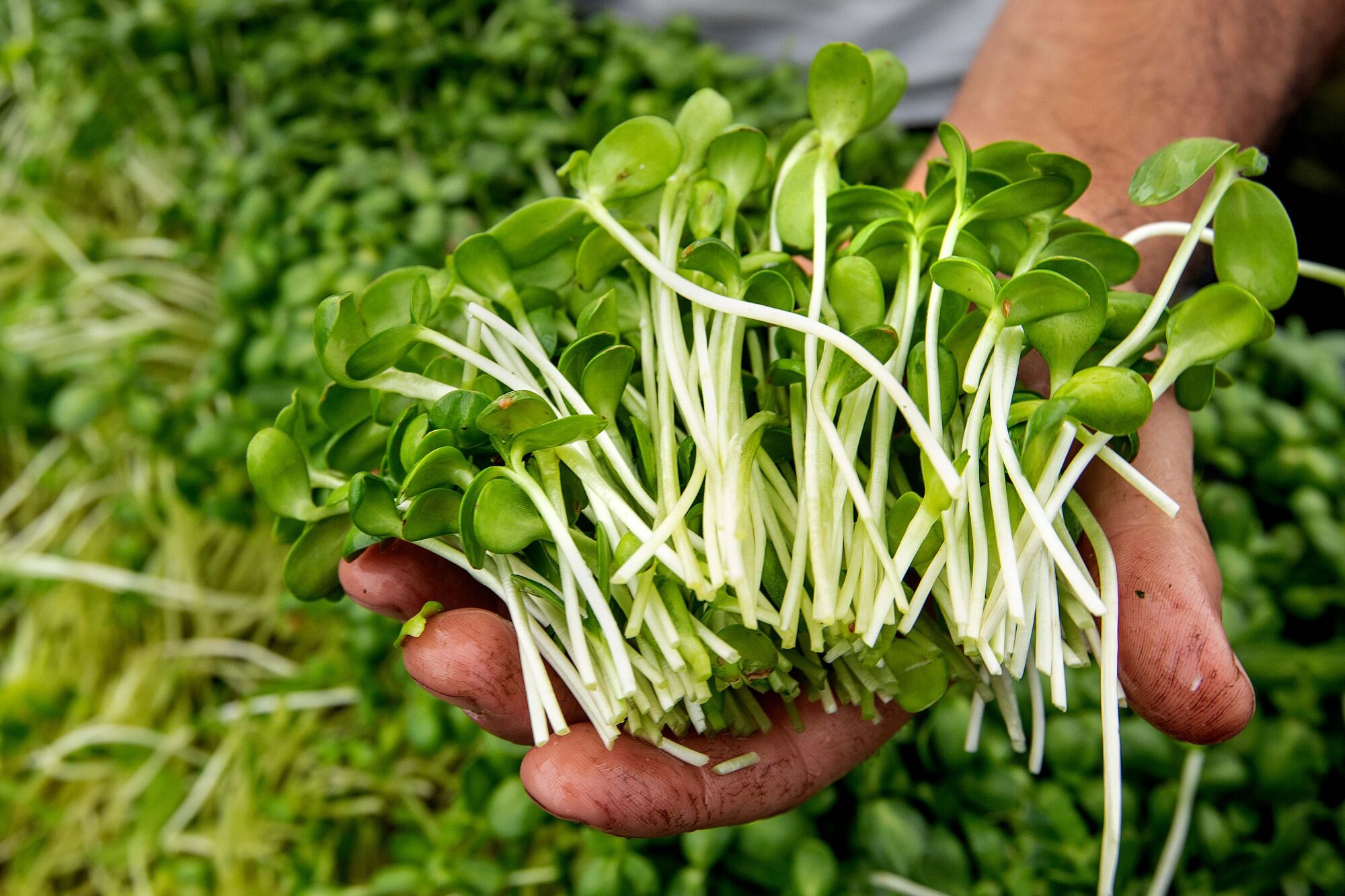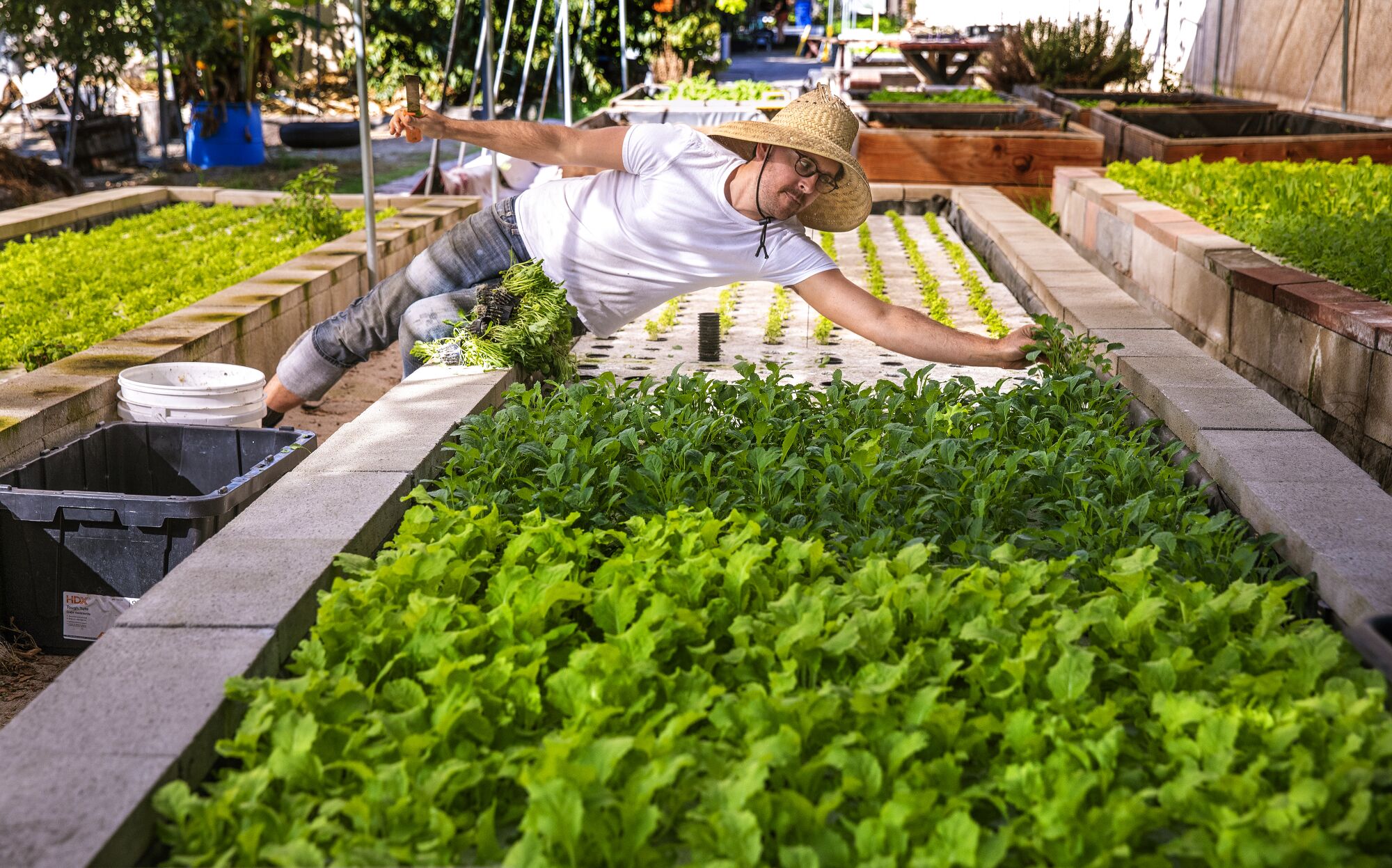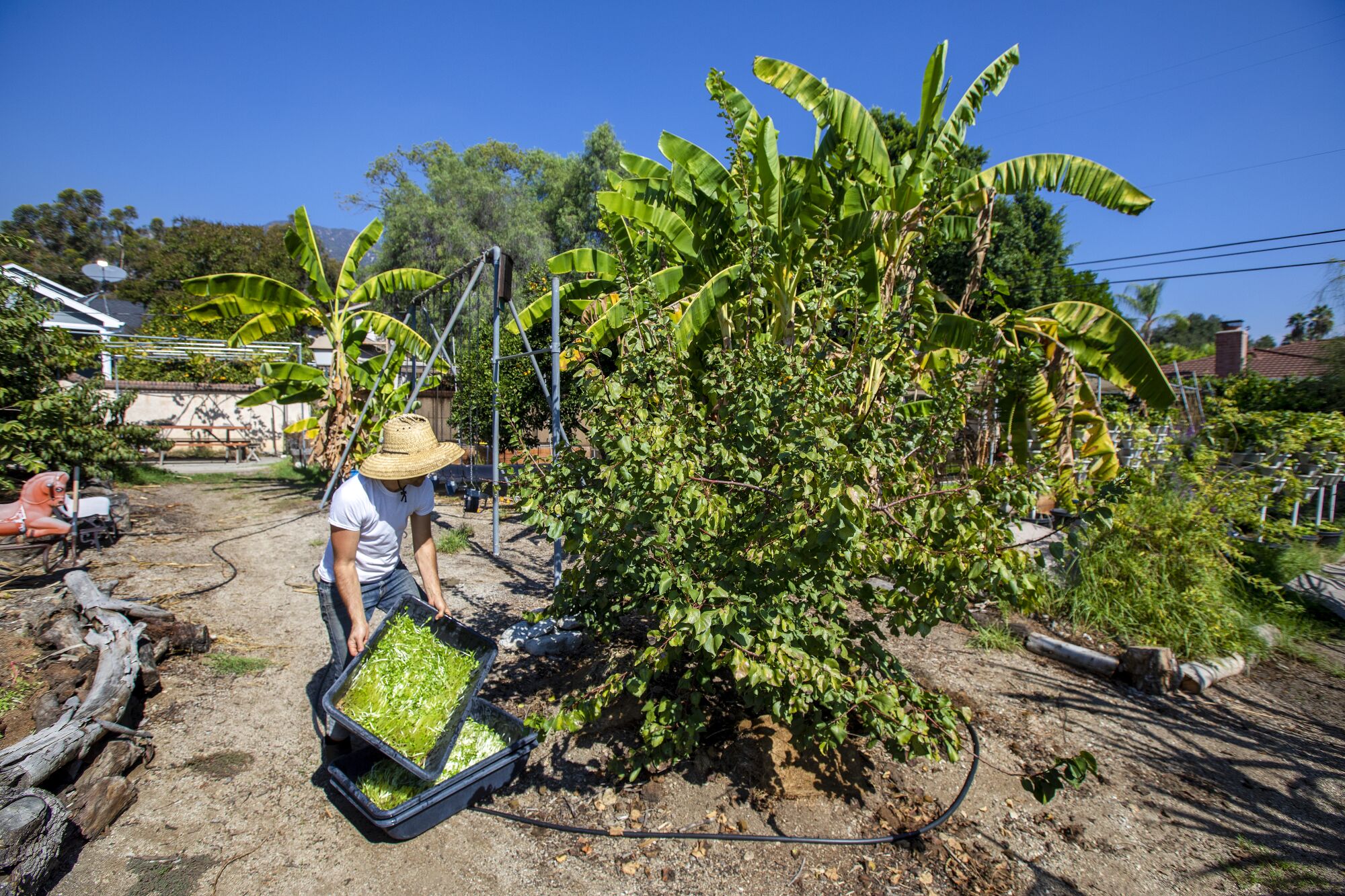They turned 4 Los Angeles yards into low-water mini-farms — and the lettuce is phenomenal
It’s a warming Sunday morning at the Atwater Village Farmers Market, and close to the entrance on Garden Avenue a chipper voice is beckoning shoppers.
“Red vein sorrel!”
The voice belongs to Mike Wood, the owner-farmer of Huarache Farms. He stands behind a table, wearing glasses, sandals, running shorts and a straw hat, which has a hole in its crown from rubbing against low-slung orange branches.
Unlike other stands, stuffed with bunches of dirt-covered produce, Mike’s spot is lined with leafy greens and sprouts that have been trimmed and washed; they rest in large plastic bins with silver tongs for scooping. Small black placards with white handwriting inform shoppers of names, prices, nutritional value and use.
Wood’s farm is as nontraditional as his market setup. It’s a collection of four backyards: three in Sierra Madre and one in Glendale that run on a combination of hydroponic systems, wicking beds and vertical bins that use recycled water.

Mandy Wood, co-owner of Huarache Farms, tosses harvested sunflower sprouts into a container after washing them.
(Mel Melcon / Los Angeles Times)
“He’s a total food nerd,” says his wife and business partner, Mandy Wood, commenting on how Mike will check the Centers for Disease Control and Prevention’s list of most nutritious fruits and vegetables to decide what to grow. “I just eat what I feel like eating,” she says, although her diet is still fueled by their farm collective.
It’s now Friday, two days before the market, and Mandy is rinsing and spinning sorrel in a giant salad spinner that’s popular on farms in France. She is at home, both literally and figuratively: Huarache’s headquarters is Mandy’s childhood home.
Also home to two boys ages 10 and 15, the place has a lived-in, “Swiss Family Robinson” feel. A jungle of sugar cane surrounds the trampoline and the treehouse. A tall banana tree provides some shade for the swing set, which looks like a 1980s public park swing set because it is one; Mandy’s father was once a handyman for Los Angeles’ Department of Recreation and Parks, and he ordered it from the city’s vendor.
Mike and Mandy met in 2005 at Citrus Community College in Glendora. Attracted to Mandy’s curly hair, he sat beside her and, in an attempt at coquetry, opened an H.P. Lovecraft book.
He was studying forestry, and his professor suggested that the best way to preserve the biodiversity of forests would be to stop large-scale industrial farming. Smaller, more diversified farms would improve the environment and reduce wildfires.

Mike Wood, co-owner of Huarache Farms, harvests sunflower sprouts growing at the Sierra Madre location.
(Mel Melcon / Los Angeles Times)
Mike went on to Cal Poly Pomona to study agriculture and became interested in aquaponics. He built an aquaponic system in the backyard and transformed Mandy’s pool into a freshwater pond for tilapia. The pond reverted to a pool after Mandy — needing a swim on a 100-degree day — smacked a fish by accident. “That was it,” she says.
This was 2014, and Mike was raising chickens too. He grew food to feed his 20-odd fish, and the chicken feed included cayenne pepper, which reddened the yolks. Customers loved this. Mike expanded to 100 chickens. A cacophony of clucks led to neighbor complaints, followed by a citation from the city.
Mike had been growing his animal feed hydroponically and figured it would be more ecologically efficient to grow plants for people instead of growing feed for animals to become our food. “It’s easier to take care of plants than it is to take care of animals,” he says with a chuckle. “They’re much more forgiving.”
From 2017 to 2020, Huarache Farms grew into the cooperative it is today. Mike met Edwin Tomyoy, a chef who used to sell with him at the farmers market. Tomyoy helped Mike transition to veggies; they amicably parted ways during the pandemic. In 2018, while at his kids’ school, Mike met Dan Farnam and Bryan Blackburn, whom he refers to as the vegan dads. They bonded over vegetables, farming and running. The dads asked if Mike would help them build a hydroponic system, then asked if he’d sell their excess produce.
In 2019, Mike added two more backyards: Sunland Farm in Glendale and the Wood Farm (no relation to his name) in Sierra Madre. He also met Isaac Qureshi and Erika Hang, who had Sustaina, a business platform. They helped Mike create an accounting system to accurately split the payments between him and the various backyards; some of them would get 60% because they tilled while Mike sold, others 40%. Through Sustaina, Huarache also launched a Community Supported Agriculture box, which delivers around Sierra Madre. Because people were looking for alternative grocery options at the start of the pandemic, it went from delivering five CSA boxes a week in 2019 to more than 70 in 2020.

Mike Wood, co-owner of Huarache Farms, harvests kale, grown hydroponically at its Sierra Madre location. In foreground is mustard.
(Mel Melcon / Los Angeles Times)
By 2020, his vegetables were a hit at the farmers market, and pandemic-addled customers seeking a break from self-isolation volunteered to help harvest. After the harvests, they’d host a dinner. Mandy was now on board full-time, having quit her clerical job at a hospital to help streamline things and get her “hands dirty.”
As Mandy helps tighten schedules, bookkeeping and sorting, Mike continues to refine the farming. Like most local farmers at the market, Huarache’s food is delicious and nutritious because of its proximity, which allows for harvest just days before going to market. Food in the grocery store has been harvested weeks and sometimes months prior, a process that reduces flavor, color and nutritional value.
Huarache doesn’t use manure, and because it grows diverse crops in high-yield, low-impact ways, it doesn’t use chemicals or pesticides, making its produce safe to eat right from the ground. Crops are harvested before pests become a problem, and there are too many varieties for an infestation. Plants grow hydroponically, and Huarache infuses the water with Sea-90, a dense mineral compound that enhances the macro- and micro-nutrients while keeping plants drought-resistant.
No water is wasted. The hydroponic systems — seven total — each use 2,000 gallons but need to be filled only once. Mike keeps evaporative heat at bay via sunscreens that reduce the temperature over his crop by 10 degrees and shield them from getting fried. Hanging 8 feet overhead, these tan nets are an idea copied from Kahsay Gebretsadik, an Ethiopian farmer who transformed his desert home into an oasis of produce.
Mike explains how his system works and his philosophy of farming while cutting kale from its planter cube, hacking the leaves to be sold and discarding the planter cube into a bin. This “green manure” will be scattered under Huarache’s 200 fruit trees, reducing the amount of water the trees need from 7 feet a month to less than a foot. Industrial farmers forgo this step because of labor costs and because they lack plant diversity. “This stuff is like gold to me,” he says. “I couldn’t imagine throwing it away; our fruit trees are in walking distance.”
He then points to his 28 wicking beds. “They’re essentially hydroponics without the moving parts,” he says, because, although they use dirt, the raised beds are lined in the same plastic that lines backyard ponds and filled with soil. When plants are watered, the water is retained and wicks back to the roots, unlike systems in the ground, which lose water to evaporation, runoff and as water passes beyond the roots. In cooler weather, residual water will pass through a drainage system, collected for later use.
Occasionally, recaptured water is released into stacked planters with a crack and hiss reminiscent of sprinklers in the produce section of a grocery store. There are several stacked planters at the headquarters, 60 at Wood Farm and 23 at Sunland. “If you can stretch out that water as you make your way down, then you’re growing more food using the same amount of water,” Mike says.
His total weekly water usage at the headquarters is about 529 gallons a week. Using the University of California’s estimates for plants in soil, traditional farming in the same surface area would require roughly 857 gallons a week. Sunland Farm uses the most water, due to the number of fruit trees, but it’s still less than would be used in a traditional garden.
“Farmers need to be frugal,” says Mike. “The farmer that’s more successful is the one that saves the most money and is able to get more with less while spending the least amount of time on the farm.” Efficiencies abound. The house is powered by solar. Storage fridges are on timers, so they run only on the days between harvest and the market.
Huarache’s backyards total 4,080 square feet. Each week they produce 10 pounds of greens, 110 bundles of herbs, seven pints of strawberries, 30 bundles of green onions, 45 zucchini, 50 to 60 trays of tomatoes, 15 pounds of turnips or radish (depending on the season), 10 to 15 Chinese eggplant and a varying supply of oyster mushrooms, ice cream bananas, papayas, oranges and mulberries.

Mike Wood, co-owner of Huarache Farms, prepares to toss green manure onto the roots of an apricot tree.
(Mel Melcon / Los Angeles Times)
The couple’s ambitions for Huarache are simple. “I’m just happy to feel like a human again,” says Mandy, who enjoys more time with her family and more time outside, away from screens.
Mike agrees, adding, “My goal is to inspire and demonstrate that a small farmer that grows a thousand things can actually be more efficient than a farmer who’s growing one thing over a much larger piece of land.”
He says this humbly, unaware he has just planted seeds.
For more latest Food & Drinks News Click Here

